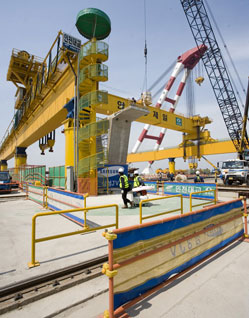A Key Economic Link Highlights Complex Deals and Contractor Revisions
At opposite ends of South Korea, two monumental bridges are emerging from the mainland. Both are technically daring, but the 12.3-kilometer-long Inchon Bridge is breaking new ground in Korea by using foreign leadership and excluding contractors from its investors.
The Inchon Bridge linking the mainland to Yeongjong Island and Seoul's international airport, and the 8.2-km-long Busan-Geoje crossing, on the southeast coast, together cost some $2.5 billion. Both are long sea crossings incorporating major cable-stayed spans.
|
Traversing one large body of water, Inchon has a single cable-stayed navigation span. In contrast, Busan's link hops between islets with a pair of cable-stayed bridges and one of the world's deepest sunken-tube tunnels.
Both projects are privately financed, with Busan's using the traditional Korean approach. A team of Korean contractors not only controls the 40-year toll concession, but also provides financing and handles design and construction.
 Michael Goodman/ENR Inchon Bridge will create new airport link with Korean city.
|
But when Soo-Hong Kim, now president of Amec Korea, conceived the idea of the $1.7-billion Inchon Bridge, he wanted to break away from this Korean model for privatized projects. He says contractors have a poor reputation after participating in billions of dollars worth of privately financed jobs. "People think that construction companies are taking too much profit," he says.
Financial Twists
 |
In the late 1990s, when South Korea was in a financial crisis, citizens donated gold and jewelry to the government to bolster the economy. Kim says he envisioned a bridge financed by foreigners as a way of importing much-needed currency.
To develop the project, Kim says he recruited Toronto-based design firm AGRA Inc. to submit an unsolicited bid for the concession to the government. When London-based Amec plc bought Agra seven years ago, it acquired the bid.
Amec became the government-appointed "potential concessionaire" in 2001. It was joined a year later by Inchon City government as a partner in the project's company KODA Development Co. Ltd, then 51% controlled by Amec.
 Michael Goodman/ENR Approach spans are placed by balanced cantilever; viaduct spans by gantry.
|
To overcome potential conflicts of interest in having contractors as investors, Kim excluded them from KODA, now renamed Inchon Bridge Co. Ltd., and he made the unusual move of including competitive bidding for the turnkey construction. That involved working with official rules requiring that all terms of a privately financed concession, including cost, be agreed upon at once, says Kim.
Traditionally, a Korean joint venture would sign a government concession based on an agreed-upon design. The cost then would be calculated by applying official unit prices for all elements in the design, which eliminates incentives for efficiency, says Kim.
 Michael Goodman/ENR Nearly 900 concrete segments comprise approach spans.
|
To comply with the requirement to agree upon all terms at once, Amec's project team committed to a cost calculated by its own engineers and others. It would later bid the work for the real price.
KODA signed a 30-year concession agreement with the Ministry of Construction and Transportation in 2003. In 2004, it bid the turnkey contract, receiving offers from two groups.
 Michael Goodman/ENR Segments are precast at yard in Songdo, Korea.
|
With a roughly $1.4-billion price, the offer from a joint venture led by Korea's Samsung Corp. came in 21% under the concession agreement's estimate, says Kim. Samsung's price was higher than a rival's, but it was more attractive after an analysis of conditions, he adds. The resulting cost savings from bidding the construction will allow officials to reduce future tolls on the bridge by nearly 30%, says Kim.
Though Inchon Bridge Co. shoulders the risk on the project, risk is substantially mitigated by government support. The Korean government provides 49% of construction subsidy, underwrites loans raised to finance the work and guarantees a minimum toll revenue.
 Michael Goodman/ENR Bridge segments are match cast.
|
The deal between the bridge company and the government was finally closed in mid-2005, when site work formally began. Amec will progressively reduce its stake during construction to 23%. Amec retained its role as project manager with an option to operate the crossing during it first seven years.
Airport Approach
The Inchon bridge will form the main section of a new expressway running more than 21 km from near Seoul's main airport on Yeongjong Island to Inchon City and on to existing trunk routes.
The crossing's main feature is a 1.48-km-long cable-stayed bridge with an 800-m steel box-girder main span. On either side, there are 889-m-long approaches...
 Related Links:
Related Links: 
